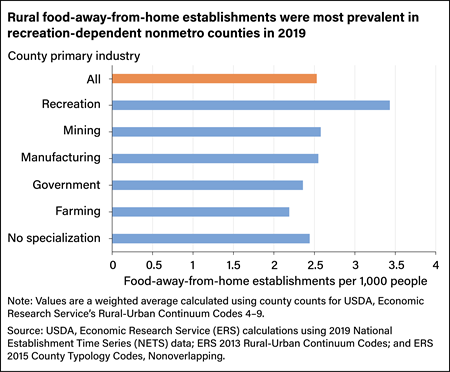Among Rural U.S. Counties, Those With Recreation-Dependent Economies Had Most Options Per Capita for Dining Out in 2019

Rural U.S. counties differ from urban counties in marked ways, but they also can be distinguished from one another. For example, rural counties have different leading industries, such as farming, mining, or recreation. The availability of restaurants and other food-away-from-home (FAFH) outlets varies across rural counties, and those that depend on natural amenities, tourism, and recreation generally had more options for dining out leading up to the Coronavirus (COVID-19) pandemic. In 2019, the rural counties whose economies depended on recreation had more FAFH establishments per 1,000 people than rural counties with other leading industries.
Rurality is defined by population size and nearness to metropolitan centers. The most rural counties are those that have low populations and are not adjacent to metropolitan counties. A broader term, “nonmetropolitan,” refers to any county that does not encompass a metropolitan city. Researchers at USDA, Economic Research Service and the University of Arkansas examined all nonmetropolitan counties collectively and by more specific measures of rurality. Nationally, roughly 2,000 U.S. counties were considered nonmetropolitan in 2019. About 12 percent of those counties were characterized by natural amenities, with recreation as their primary industry.
Rural recreational counties are varied and can be found in many States across regions. They include counties that overlap with national parks, such as Grand County, Utah, which is home to Arches National Park and a portion of Canyonlands National Park. They also include counties that attract visitors to State parks or undesignated natural amenities. Examples include Tioga County, PA, which is home to multiple State parks, forests, and other recreation areas; Greene County, GA, home to Lake Oconee and its surrounding national forest; and Hawaii’s Kauai County.
The researchers found that in 2019, across all nonmetropolitan counties, counties with an economic dependence on recreation had the highest per capita number of FAFH establishments at nearly 3.5 establishments per 1,000 people. This value represents a higher density of FAFH establishments than is found on average in any type of metropolitan county, where the ratio ranges between 1.4 and 3.1 establishments per 1,000 people. Other types of rural economies, such as those that depend on farming, mining, or manufacturing, have more modest availability of restaurants and other FAFH compared with those of equivalent size and proximity to metro areas whose economies depend on recreation.
The Rural Food-Away-from-Home Landscape, 1990–2019, by Keenan Marchesi, Anne Byrne, and Trey Malone, ERS, March 2023
COVID-19 Working Paper: Food-Away-From-Home Acquisition Trends Throughout the COVID-19 Pandemic, by Keenan Marchesi and Patrick W. McLaughlin, ERS, May 2023
Food Access Research Atlas, by Alana Rhone, USDA, Economic Research Service, April 2024
The Food Retail Landscape Across Rural America, by Alexander Stevens, Clare Cho, Metin Cakir, Xiangwen Kong, and Michael A. Boland, ERS, June 2021


